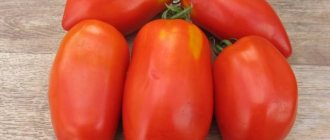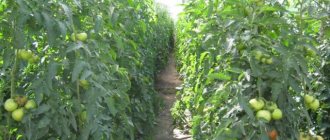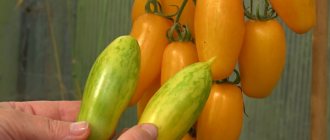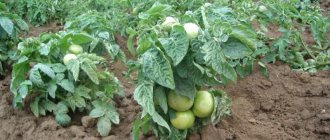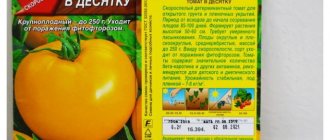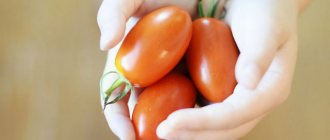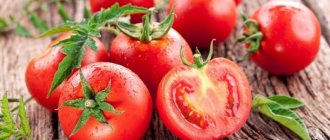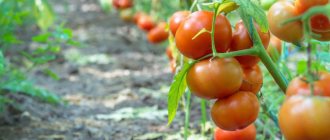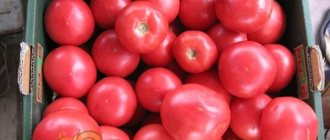Some tomato lovers criticize hybrids, considering them less tasty and healthier than varieties. Others, on the contrary, choose hybrids because they are more productive and less susceptible to various diseases. Every year, new tomato products appear on the shelves of garden centers, most of them are hybrids. Let's look into this tomato story.
- What does a tomato variety and hybrid mean, what is the difference
- What is the advantage of hybrid tomatoes over varieties
- What are the possible disadvantages of growing hybrid tomatoes?
- Classification of tomato hybrids by ripening period
- The best tomato hybrids
- Tomato hybrids for greenhouses
- Tomato hybrids for open ground
- Tomato Hybrid Tarasenko
What does a tomato variety and hybrid mean, what is the difference
A variety is the result of many years of selection and reproduction of the most productive and stable parent pairs of plants. Varietal crops retain their properties in the next several generations. Seeds of any variety can be grown independently; they repeat the parental characteristics. Perhaps this explains the huge (most likely incalculable) popular selection of tomatoes.
On packets of seeds next to the name you can see the designation F1 . This suggests that this is not a variety, but a hybrid form. The abbreviation is easy to decipher:
F is the first letter of the word children (filii); 1 - first generation.
Hybrids are obtained by crossing specially selected plants of different varieties. An F1 tomato hybrid occurs when you have two tomato plants of different varieties, and then one is pollinated with pollen from the other variety. The seeds of the resulting cross-pollinated tomato will produce plants that are F1 hybrids (first generation hybrid). The descendants of F1 hybrids are F2. The descendants of F2 are F3 and so on. Hybrids are more productive and of higher quality than varieties, but retain their properties only in the first generation. There is no point in collecting seeds from hybrids. They do not repeat the original qualities, and most often grow up much worse than their parent pairs.
Pink hybrid for greenhouse F1 Donna Rosa (photo: www.udec.ru)
Hybridization requires protected soil and manual labor, so the cost of such seeds is higher than varieties.
To debunk a myth that we sometimes encounter, let us remind you that F1 hybrids are not genetically modified. These are completely natural plants, bred in the traditional way.
Instructions for use "Oxychoma":
20 grams of powder dissolves in 10 liters of water. The plant is sprayed daily for one week. Very important! Do not use the product during mass flowering of tomatoes.
For 10 square meters you need 2 liters of solution.
Treatment should be carried out wearing a respiratory mask to avoid burns to the respiratory tract. Smoking, drinking and eating are prohibited during the procedures.
What is the advantage of hybrid tomatoes over varieties
By giving preference to hybrid forms of tomatoes, gardeners receive several advantages:
- the tomato yield is many times larger (this phenomenon is well known as hybrid energy);
- ripening time is reduced;
- fruits are one-dimensional, even in shape, color, weight;
- the pulp has a harmonious taste, a rich set of nutrients;
- plants get sick less often, do not suffer much from pests, and adapt well to weather conditions.
Series of tomato hybrids “Great”
Treatment methods
Undoubtedly, it is easier to prevent the disease. But if it does appear, treatment is necessary. Fungicides are used for this. Work best: "Ridomil Gold".
Standard instructions for use of "Ridomila Gold":
Mix 25 grams of fugnicide in one bucket of water (10 liters). We process once a week (4 treatments in total). The product should be used in the morning in dry weather. You can harvest the crop two weeks after the last procedure. To treat Alternaria, 60 grams of the drug is used.
Late blight is accompanied by bright brown spots on the leaves, which progress and are very quickly transferred to the stem and fruits, after which the plant dies. The optimal environment for the development of the disease is high humidity in the leaves.
For treatment, you can use fungicides (Oxychom, Ridomil Gold, Fitosporin and Ordan) and biological agents (Alirin-B, Gamair) and biological agents (Alirin-B, Gamair) ).
All drugs that have a biological origin are used equally in two ways, and alternate with each other:
- One tablet is diluted in five liters of water and poured under the root of the tomato.
- Two tablets of the drug are diluted in one liter of warm water and used for spraying.
What are the possible disadvantages of growing hybrid tomatoes?
When purchasing seeds of a favorite variety, an experienced gardener analyzes its characteristics at the end of the season: early ripeness, yield, taste, color, care features. If everything suits him, he selects high-quality ripe fruits and releases seeds from them. Next year you can use your own seeds. All varietal qualities are preserved.
In the case of F1 hybrids, seeds will have to be purchased annually; it makes no sense to purchase the hybrid form yourself. The second generation may unpleasantly surprise:
- the bushes will be of different heights;
- fruits may vary in color, shape, size;
- low yield;
- if the manufacturer doesn't release a given hybrid for whatever reason, you're stuck. Once the seed is gone, it's gone forever.
tomato F1 Orange Santa
Reviews
Every year I grew indeterminate tomatoes, but I really didn’t like their late harvest, since I couldn’t spend the whole summer at the dacha. This year I decided to try Generator. I was satisfied, although the constant stepson was very annoying. But it was worth it. The harvest is very large, and the tomatoes have high taste. I really liked the fact that I had to stay at the dacha, can it and then take the jars home. I immediately packed it into bags and transported it. The fruits did not choke or crack.
I have been growing this variety for a long time. The whole family loved it very much for its ease of care and high taste. The only difficulty is stepsoning. If you want a good harvest, perhaps even for sale, this variety is for you.
Classification of tomato hybrids by ripening period
When choosing a tomato hybrid, be sure to look at the ripening period. It depends on whether it will have time to form a crop in your strip, and whether or not it is suitable for growing in open ground (in a greenhouse, as a rule, there are no problems, but outside the heat may not be enough). So:
The classification of hybrid tomato seeds is as follows:
early ripening, or so-called early - 85-105 days from germination to the beginning of ripening; mid-early - 106-110 days; mid-season - 111-115 days; medium late - 116-120 days; late ripening - more than 120 days.
Moreover, in different years and in different regions, the growing season of the same variety or hybrid of tomatoes for open ground and greenhouses can be different.
Regarding germination
This is the very last stage of preparation. There are absolutely no difficulties. The action begins 55-60 days before planting in the ground.
Tomato grains are placed in gauze (or natural fabric), placed on a tray or any flat surface and placed under a lamp or any other warm place. Until the grains have sprouted, they should be periodically sprayed with water to maintain moisture. It is not worth pouring so that the “embryos” do not get wet. As soon as you notice a tiny sprout that has emerged from the shell, start sowing into the ground.
When planting, caution is very important, because if the shoots are damaged, the plant will not sprout.
After five to seven days, shoots should appear.
Tomatoes are planted in the ground when the seedlings reach 2 months and at least 25 centimeters in height. You should also pay attention to the soil temperature. Optimal - 10 degrees. The higher the better. It is best to plant up to 6 plants per 1 square meter.
Planting “Generator” is no different from planting other varieties.
The best tomato hybrids
Fortunately for us, tomato enthusiasts, today there are many varieties; it is simply impossible to count all the varieties and hybrids. For example, the “Author’s Varieties and Hybrids” series alone includes about 300 items. Available in a rainbow of shades, from red to yellow and purple, in all shapes and sizes, from a tiny cherry to a kilogram giant.
Read about the most interesting yellow tomatoes in this material >>>>>>>
There are special series of hybrids, which include:
- the most delicious tomatoes (“Vkusnoteka”, “Oriental Delicacy” from Search, including hybrids: F1 Coral Reef, F1 Magic Harp, F1 Golden Stream, F1 Chinese Souvenir);
- the most stable (“Special Hybrids” from Biotechnika);
- multi-colored (for example, “Crimson Miracle”);
- compact and for balconies (for example, the “4 summer” series Search);
- especially healthy (usually combines yellow and orange tomatoes);
- a series of tomatoes that do not require pinching (for example, “Nepas”)
- cherry (series “Sweetie”, “Sweets from the garden” SeDek)
Read about how to choose truly black tomatoes here >>>>>
Tomato F1 Sweet million (considered an analogue of F1 Red bunch)
How is sowing done?
The tomato is a hybrid, so the seeds must be purchased at a specialty store. Before planting seeds, it is necessary to prepare the soil and treat the seeds with manganese. This must be done to prevent future tomatoes from contracting the disease. The seeds are sown to a depth of 2 cm and the box must be placed in a warm and sunny place.
After the seeds have hatched, after the first leaf it is necessary to prick the seedling in order for it to strengthen. Plants must be planted when they are 55 days old. To obtain earlier fruits, you can plant seedlings in a greenhouse. Care consists of regular watering, loosening the soil and fertilizing the plant. On average, there are 3 adult plants per 1 square meter. In these growing conditions they will feel comfortable and bear fruit.
Tomato hybrids for greenhouses
To use the greenhouse productively, try to grow vigorous hybrids (indeterminate). They will grow to the ceiling, which means they will produce more fruit per unit area. Follow the seed manufacturer's recommended planting pattern and do not plant plants too close together.
Tomato F1 Forte Rose (from Semko) pink hybrid: quite early, suitable for greenhouses. May crack in heat.
If you need tomatoes for growing in a greenhouse, suitable for canning , then you can pay attention to the hybrids of the “Tsar” series (SeDek): F1 Empire, F1 Empress, F1 Russian Empire, F1 Peter the Great, F1 Peter the Great. They are tall and set fruit well even in low light conditions or in conditions of temperature changes. The tomatoes of these hybrids are perfectly preserved both on the bush and during storage.
Tomato series F1 Russian Empire and F1 Peter the Great
Fruitful salad-type giants for the greenhouse are included in the “Great Tomatoes” (SeDek) series: F1 Alexander the Great, F1 Vladimir the Great, F1 Catherine the Great, F1 Dmitry the Great. They are distinguished by their large size, rich taste, resistance to tobacco mosaic virus, verticillium and fusarium wilt, cladosporiosis and other diseases; high stress resistance.
For the southern regions and high greenhouses the series of cherry tomatoes “Octopus” (SeDek) has gained particular popularity, these are the so-called tomato trees: F1 Octopus cream raspberry, F1 Octopus cream orange, F1 Octopus cream chocolate, F1 Octopus cherry raspberry, F1 Octopus cherry . All of them are incredibly productive and resistant to many tomato diseases.
F1 Opera is one of the earliest ripening hybrids for greenhouses. Plant height is 1.5 m. The fruits are round, even, smooth, weighing 100–110 g. Thanks to the pronounced tomato aroma and harmonious taste, they are especially good fresh, but are also suitable for canning. The variety is very productive – 5–5.5 kg, maximum – 8.5 kg. Resistant to many diseases.
Cherry tomato hybrids occupy leading positions :
F1 Strawberry Indeterminate hybrid of cherry tomato with a beautiful and original heart-shaped or “strawberry” fruit shape. The tomatoes are collected in elegant, even clusters of 18–30 pieces.
F1 Miracle Bunch Hybrid is characterized by high growth energy, bears fruit until autumn and is resistant to a range of diseases and various weather stresses. The first fruits are ready for harvest after 90–95 days.
F1 Blue bunch Indeterminate mid-season cherry tomato hybrid with fruits that play in the sun with all shades of blue and blue!
Cherry tomatoes
Features of cultivation, planting and care
We recommend sowing the seeds of this tomato for seedlings 60-65 days before the intended planting in the ground. Seedlings dive at the stage of two true leaves. When planting seedlings in a permanent place per 1 sq. It is recommended to place up to 3 plants per meter of land; when forming into 1 stem - up to 4.
Further care for tomatoes consists of timely watering, fertilizing with complex mineral fertilizer, pinching and preventive measures to protect against diseases and pests.
Tomato hybrids for open ground
When choosing tomato hybrids for open ground in the Middle Zone, give preference to early and mid-early ones. The standard type of growth has the advantage; determinant ones are also suitable. and of course, for open ground it is vital that the tomato is resistant to late blight, a sinister disease of nightshades. It won’t hurt if the manufacturer promises that the hybrid is capable of ripening if the bush is harvested prematurely (such as F1 Caspar 2, F1 Torbay).
Lovers of sugar and meaty tomatoes will appreciate a series of beef tomatoes suitable for growing in open ground and film greenhouses: F1 Openwork, F1 Barin, F1 Bourgeois, F1 Fat, F1 Doll, F1 Doll Dasha, F1 Doll Masha, F1 Gift for a Woman. These are beef tomato hybrids with determinate type plants.
Tomato F1 Openwork
Hybrid F1 Red Red for open ground is attractive for its versatility, resistance to diseases and temperature changes. Can be grown in a greenhouse and in open ground. Plant height is up to 150 cm, branching is average. At the same time, the bush itself looks quite powerful due to its single strong stem. Clusters with large fruits of 5-7 pieces are formed on it. The weight of one tomato is from 200 to 500 g, manufacturers promise up to 8 kg of fruit per bush. The pulp is sweet, loose, sugary. Fruits for fresh consumption, salads and canning in the form of lecho, adjika, tomato sauce.
Read about how to properly form tomatoes here >>>>>>>
Tomatoes Surname on video
When growing tomatoes in a greenhouse, we recommend installing a drip irrigation system - this saves your time and effort, and also increases plant productivity and reduces the risk of late blight.
If you grew Familia tomatoes, please write whether you liked them or not. What was the yield and taste of the fruits like under your climatic conditions? How do you rate the disease resistance of this hybrid? Briefly write down the advantages and disadvantages of this tomato in your opinion, and evaluate its taste. If possible, attach a photo of your tomatoes to your comment. Thank you!
Your reviews of the Surname tomato and additions to the description will help many gardeners evaluate this hybrid more objectively and decide whether it is worth planting or not.
Prudent summer residents plant only those varieties of tomatoes that have proven themselves well, or produce their own seeds. However, new products appear on the market from time to time that you can plant without worrying that the experiment will be unsuccessful. Surname F1 tomatoes are such reliable and unpretentious cultivars.


